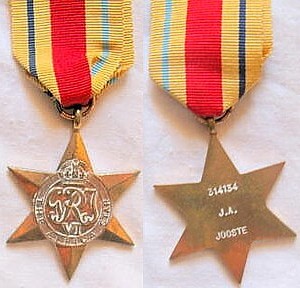The Second World War Stars
On 8 July 1943, the 1939–43 Star (later named the 1939–1945 Star) and the Africa Star became the first two campaign stars instituted, and by May 1945 a total of eight stars and nine clasps had been established by the United Kingdom to reward campaign service during the Second World War. [3] One more campaign star, the Arctic Star, and one more clasp, the Bomber Command Clasp, were belatedly added on 26 February 2013, more than sixty-seven years after the end of the war. [1] [2] [4]
Including the Arctic Star and the Bomber Command clasp, no-one could be awarded more than six campaign stars, with five of the ten clasps awarded denoting service that would have qualified for a second star. Only one clasp could be worn on any one campaign star. The maximum of six possible stars are the following: [1] [4] [3]
All recipients of campaign stars also received the War Medal. [14]
Institution
Between 10 June 1940 and 12 May 1943 British forces fought in North Africa against the Germans and Italians, who had control of large areas of Egypt, Libya and Tunisia and therefore threatened the Suez Canal and the approaching sea lanes. During the desert conflict the balance of power alternated between the two sides, until the remaining German forces surrendered at Tunis on 12 May 1943. Some historians consider the victory over the German forces in North Africa to have been the turning point in the war which led to the eventual defeat of Germany. [15]
The institution of the Africa Star was announced on 8 July 1943 and in August it was announced that the first uniform ribbon bars would be issued to qualifying personnel later in that year. The medals themselves were not intended to be available until after the cessation of hostilities. Some ribbon issues to overseas troops were delayed, but many had been received by the end of 1943. [2] [16] By March 1944 1,500,000 personnel had received Africa Star ribbon bars, with further awards made by the end of the war. [17]
Three clasps were instituted: 'North Africa 1942–43', '8th Army' and '1st Army', of which only the first to be earned may be worn on the ribbon of the Africa Star. [10] [18]
Description
The set of nine campaign stars was designed by the Royal Mint engravers. The stars all have a ring suspender that passes through an eyelet formed above the uppermost point of the star. They are six–pointed stars, struck in yellow copper zinc alloy to fit into a 44 millimetres diameter circle, with a maximum width of 38 millimetres and 50 millimetres high from the bottom point of the star to the top of the eyelet. [18]
- Obverse
The obverse has a central design of the Royal Cypher "GRI VI", surmounted by a crown. A circlet, the top of which is covered by the crown, surrounds the cypher and is inscribed "THE AFRICA STAR". [18]
- Reverse
The reverse is plain.
- Naming
The British Honours Committee decided that Second World War campaign medals awarded to British forces would be issued unnamed, [22] a policy applied by all but three British Commonwealth countries. The recipient's name was impressed on the reverse of the stars awarded to Indians, South Africans and, after a campaign led by veteran organisations, to Australians. [23] In the case of Indians, naming consisted of the recipient's force number, rank, initials, surname and service arm or corps, and in the case of South Africans of the force number, initials and surname, in block capitals. [1] [18] [24] [25]
- Clasps



All three clasps were struck in yellow copper zinc alloy and have a frame with an inside edge that resembles the perforated edge of a postage stamp. They are inscribed "NORTH AFRICA 1942–43", "8th ARMY" and "1st ARMY" respectively and were designed to be sewn onto the medal's ribbon. Regulations only allow one clasp, the first earned, to be worn with the Star. When the ribbon is worn alone, a silver Arabic numeral "8", numeral "1" or rosette is worn on the ribbon bar to denote the award of the respective clasp. [1] [3] [18]
- Ribbon
The ribbon is 32 millimetres wide, with a 5 millimetres wide pale buff band, a 1½ millimetres wide Navy blue band, a 5 millimetres wide pale buff band, a 9 millimetres wide Army red band, a 5 millimetres wide pale buff band, a 1½ millimetres wide Air Force blue band and a 5 millimetres wide pale buff band. The pale buff represents the sand of the Sahara Desert while the Royal Navy and Merchant Navy, the Armies and the Air Forces are represented by the dark blue, red and light blue bands respectively. [18]
The ribbons for this medal and the Defence Medal as well as those of the other Second World War campaign stars, with the exception of the Arctic Star, were devised by King George VI. [3] [26]
This page is based on this
Wikipedia article Text is available under the
CC BY-SA 4.0 license; additional terms may apply.
Images, videos and audio are available under their respective licenses.
